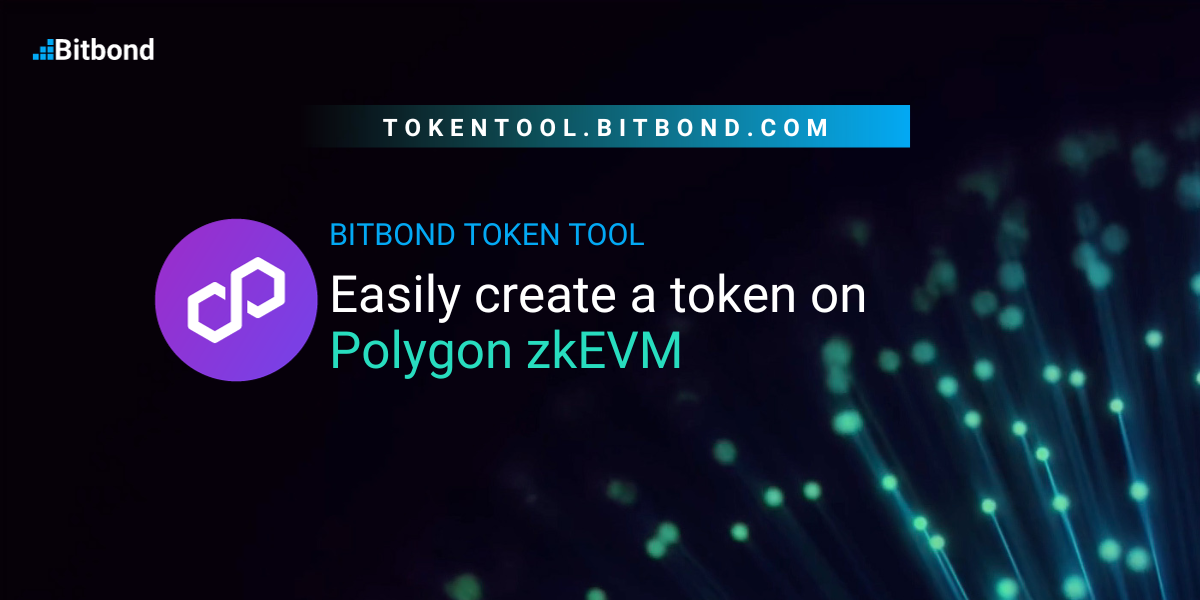Table of Contents
The cryptocurrency landscape has witnessed a surge in the number of tokens, driven by the growing interest in asset tokenization. At the time of writing over 7 million ERC20 and ERC721 tokens exist across the most popular EVM chains. As the popularity of token creation continues to rise, it’s essential to understand the intricacies of smart contract development, the cornerstone of blockchain-based tokenization.
Bitbond Token Tool simplifies and democratizes this process. It’s a user-friendly web3 platform that streamlines the creation and deployment of smart contracts for Polygon zkEVM tokens. With Token Tool, minting your unique Polygon zkEVM tokens is just a few clicks away. All you need to do is specify the blockchain network, token standard, and token attributes.
Token Tool handles the technical complexities of smart contract implementation, allowing you to focus on defining your token’s features for success in the crypto market.
Benefits of using Polygon zkEVM for token creation
Polygon zkEVM is a Layer 2 scaling solution for Polygon PoS chain that uses zero-knowledge proofs to achieve significantly lower transaction fees and faster transaction times. This makes it an ideal choice for creating and deploying tokens, as it allows you to save money on gas fees and provide your users with a faster and more seamless user experience.
Here are some of the specific benefits of using Polygon zkEVM for token creation:
- Lower transaction fees: Polygon zkEVM offers significantly lower transaction fees than Ethereum, making it a more cost-effective platform for token creation.
- Faster transaction times: Polygon zkEVM transactions are processed much faster than Ethereum transactions, providing your users with a more responsive and user-friendly experience.
- Security: Polygon zkEVM inherits the security of Ethereum, ensuring that your tokens are safe and secure.
- Scalability: Polygon zkEVM is highly scalable, meaning that it can handle a large volume of transactions without sacrificing performance.
Points to Consider Before Creating Your Polygon zkEVM Token
Step 1: Choose a Supported Wallet
Before you start using Bitbond’s Token Tool, ensure you have one of the compatible crypto wallets. Token Tool supports a wide range of popular wallets, including MetaMask, Coinbase Wallet, and WalletConnect. It’s imperative to select a reputable wallet, so be sure to conduct thorough research before making your choice.
Step 2: Verify Adequate Funds in Your Wallet
Once your wallet is set up, confirm that it holds sufficient funds to cover network and service fees. These fees are payable in the cryptocurrency native to your chosen network. For example, if you opt for Polygon zkEVM as your network, you’ll need Polygon zkEVM ETH to cover the fees. You can use a Polygon bridge to bridge your assets from Polygon PoS to zkEVM.
Step 3: Select a Token Standard (ERC-20, ERC-721, or EVM Equivalent)
Choosing the appropriate blockchain network and token standard is the initial step in shaping your Polygon zkEVM token’s features. The choice should align with your selected network.
The two most common token standards are ERC-20 and ERC-721, widely supported by Ethereum. ERC-20 tokens are fungible and are typically used for security tokens, stablecoins, or utility tokens. On the other hand, ERC-721 is prominent in the creation of Non-Fungible Tokens (NFTs). If your goal is to tokenize corporate stock or real estate, the ERC-20 token standard or its EVM equivalent is more suitable, albeit not ideal for regulatory compliance. A more suitable standard would be the ERC-1400, also supported by Token Tool, with robust security token configuration features.
EVM-compatible blockchains like Polygon zkEVM, Avalanche, and BNB Chain also support token standards for both fungible and non-fungible tokens. In this guide, we’ll walk you through the process of creating an ERC-20 Polygon zkEVM Token or its EVM equivalent.
Testing Your Token on the Network
To evaluate your token’s functionality, consider utilizing a test network first. Creating a token on a test network closely resembles the process on the actual blockchain, with the exception that you use faucet coins to cover gas and service fees. For instance, Polygon zkEVM Goerli serves as a test network similar to Polygon zkEVM, utilizing Polygon zkEVM Goerli ETH for fee payments.
Easily create a token on Polygon zkEVM
Now, let’s proceed to create your inaugural Polygon zkEVM Token using Token Tool.
Step 1: Access Token Tool
Start by visiting Token Tool and select “Create Token” from the menu on the left. Token Tool facilitates seamless token creation on Polygon zkEVM.
Step 2: Choose the Network for Token Creation and Connect Your Wallet
Select the network on which you intend to issue your tokens. In this case, choose Polygon zkEVM from the network dropdown menu at the top right.
Effortlessly create a Polygon zkEVM token with Token Tool.
Next, connect your wallet by clicking the “Connect Wallet” button at the top right and select your preferred wallet. It’s crucial to ensure that your wallet is connected to the same network you’ve selected on Token Tool to avoid compatibility issues.
Select your wallet to create a Polygon zkEVM Token.
You’ll see your wallet connected, and your wallet address will be displayed.
Connect your wallet.
Step 3: Define Your Polygon zkEVM Token’s Attributes
Now, specify the basic attributes of your token, including:
- Token Name
- Token Symbol
- Initial Supply
- Decimals
You can also incorporate additional features to further customize your token. Token Tool offers several optional functionalities, which you can explore in our documentation. Configure the parameters for your Polygon zkEVM token based on your requirements.
Step 4: Create Your Polygon zkEVM Token
After defining your token’s parameters and features, review the information for accuracy and click “Create Token” at the bottom of the page.
Click “Create Token” to finalize the creation of your Polygon zkEVM token.
Step 5: Confirm the Transaction
The final step before your Polygon zkEVM Token is deployed to the network is to confirm the transaction in your crypto wallet and pay the relevant gas and service fee. Click “Confirm,” and it will take a few seconds to create your token.
Confirm the transaction to create your Polygon zkEVM Token in your wallet to pay fees.
Step 6: Congratulations, Your Polygon zkEVM Token Is Created!
Token Tool simplifies the process of creating Polygon zkEVM Tokens, automatically adding them to your wallet once the transaction is signed and processed by the network.
A pop-up window will display your block explorer link and contract address. You’ll also find an “Add to MetaMask” button to easily import and view your tokens in your wallet.
Once you successfully created your token on Polygon zkEVM. You can easily manage actions under the Manage Token function.
Streamlining Token Creation on Polygon zkEVM
Creating your own Polygon zkEVM Token used to be a complex task, requiring technical expertise. However, platforms like Token Tool have made the process remarkably straightforward and efficient. You no longer need to write the smart contract yourself; Token Tool empowers you to configure and deploy your tokens to the Polygon zkEVM network effortlessly. This streamlined token creation process contributes to the accessibility of blockchain technology and advances the world of tokenization.
Feel free to experiment by creating your own Polygon zkEVM Token on the testnet using Token Tool. If you have any questions, our team is available to assist you. Simply reach out via [email protected] or explore our resource center for more information.




